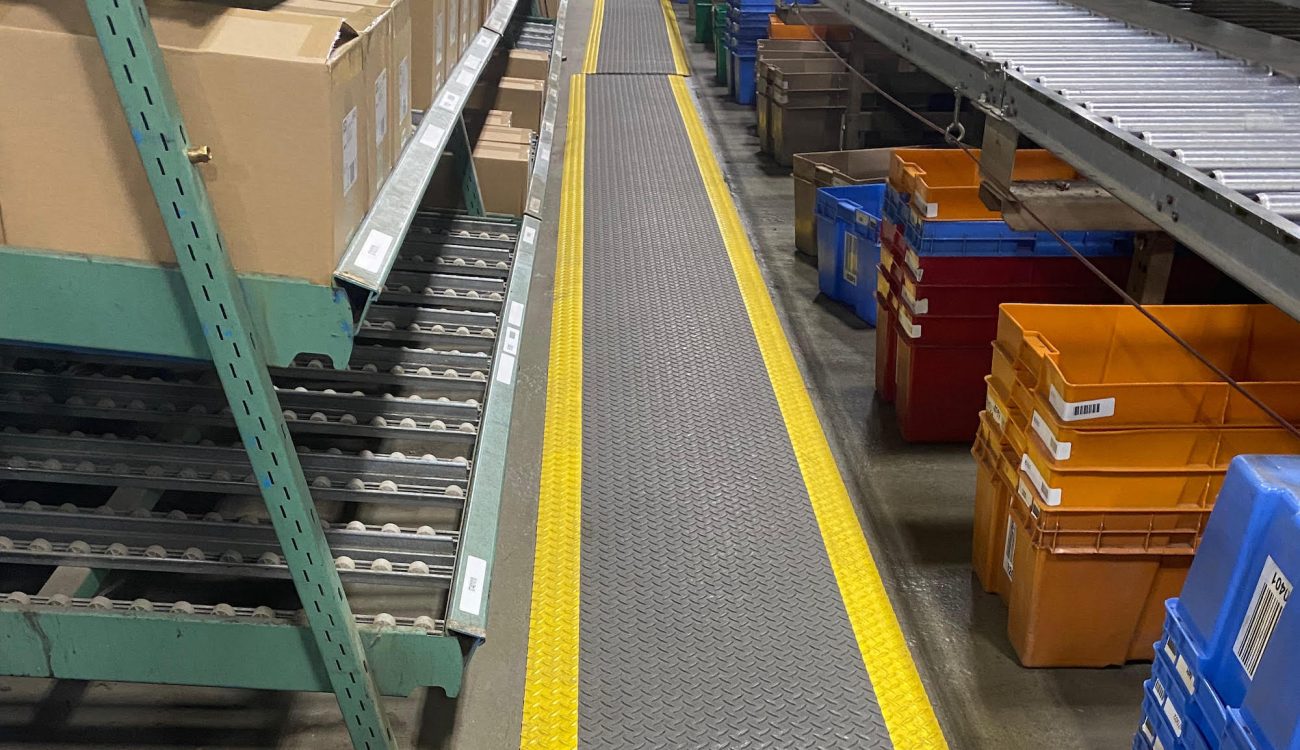In the world of material handling and ergonomics, countless products can improve the function and safety of a workplace. At Indoff, we deal in many of these products, like premium shelving, work stations, in-plant offices, and much more.
One humble but fantastic example of these products is anti-fatigue matting, which is thought to be great for both employees and employers alike. But some question the effectiveness of these mats, wondering whether they actually offer the benefits they claim to.
Let’s outline the facts about anti-fatigue mats, how they can be used with other equipment, and offer a final verdict on this ergonomic technology.
What Are Anti-Fatigue Mats For?
As the name implies, anti-fatigue mats are primarily used to reduce body fatigue. If you’ve ever had to stand for long periods of time, you may know that extended standing can make your feet, legs, and back ache.
This fatigue can make employees less productive, but it can also contribute to injuries that can sideline employees. This matting also prevents slips by providing added traction. It is intended as an affordable way to reduce discomfort and injury, which benefits employees and businesses.
Anti-Fatigue Mats Work In Many Settings
Anti-fatigue mats, like much of our ergonomic equipment, can be found in various industrial settings. These settings include workplaces like restaurants, warehouse floors, offices, and more. If employees need to stand in the same spot for a long period of time, there’s a good chance you’ll see an anti-fatigue mat underneath their feet.
Commercial and industrial matting is typically designed for solid floors and heavy-duty environments but can be used in nearly any kind of work environment. Some of the most common industries where anti-fatigue matting is used include:
- Warehousing
- Distribution
- Transportation
- Metalworking
- Electronics
- Aerospace
- Food and Beverage
- Heavy Machinery
Dry And Wet Anti-Fatigue Matting
Anti-fatigue mats are effective in wet or dry environments. If you’ve ever worked in a fast food environment, you’ve likely used a wet mat before. Dry mats may be used on a factory floor or other workplace that is likely to stay dry.
Characteristics Of Wet Anti-Fatigue Mats
Anti-fatigue mats for wet environments typically have large holes in them (like a game of Connect 4) and are elevated slightly so liquids can drain away. These holes are likely obvious; pools of water or other liquids can be a hazard for workers. These mats have raised patterns between the holes to allow for additional traction.
Characteristics Of Dry Anti-Fatigue Mats
Dry anti-fatigue mats typically don’t have the drainage holes that wet anti-fatigue mats have. Instead, dry anti-fatigue mats will utilize a solid vinyl surface with diamond plate patterning for traction. Underneath the surface, the mat will use patented closed-cell foam technology that provides much-needed comfort while being compatible with most flooring.
To top it all off, our dry mats are built to resist the most common fluids and chemicals. These mats are built to maximize comfort, safety, and performance.
Supporting Equipment For Ani-Fatigue Matting
So far, anti-fatigue matting sounds like a fantastic, simple, and versatile technology for workers. And they are! But alone, anti-fatigue mats can only help so much. Other factors should be aligned towards comfort whenever possible to get the most out of your anti-fatigue matting.
Footwear
In addition to choosing the right mat for the right job, workers should also wear the right footwear. Specifically, footwear should have enough cushioning, arch support, and heel support to alleviate the effects of prolonged standing.
Other important factors in choosing the right shoes are toebox space, material quality, and traction. Most anti-fatigue mats have some sort of pattern for grip, but having shoes that have proper traction is also a must.
Movement
Another way to alleviate pain and produce more consistent work is the ability to move throughout the day. Much of the fatigue and aching we feel during our workday is due to staying in one position too long. Taking a moment to move your legs and stretch can reduce the pain and discomfort in the feet, knees, and other parts of the body.
Flooring
Lastly, the flooring below the matting also affects the way the mat feels and functions. Obviously, many industrial settings don’t have the most comfortable flooring. However, anti-fatigue mats are designed to be placed on certain types of flooring for maximum effectiveness. It is important to have mats that match the flooring they will be used on.
Our Final Verdict
So, given all that we’ve gone over above, we can now address the main question: does anti-fatigue actually do what it purports to do? The answer is a resounding yes!
When the right mats are purchased and used alongside the proper equipment and practices, anti-fatigue mats are proven to help improve safety, health, and general well-being. At Indoff, we are proud to partner with Apache Mills to provide industry-leading anti-fatigue mats for our clients.
Choose Indoff For Top-Notch Anti-Fatigue Mats!
Anti-fatigue matting is a great, cost-effective way to make your workplace safer and more productive. To learn more about anti-fatigue matting and what they can do for your business, contact us today! Simply give us a call at 828.483.6402 to speak with our ergonomic specialist.

